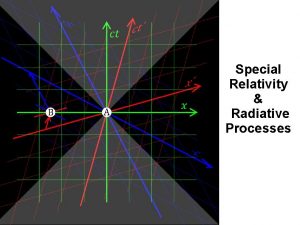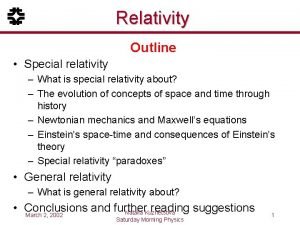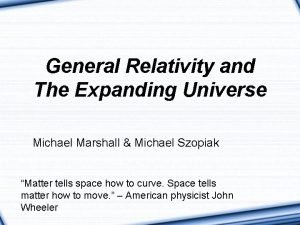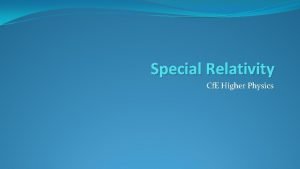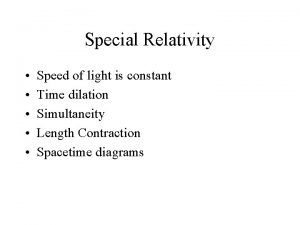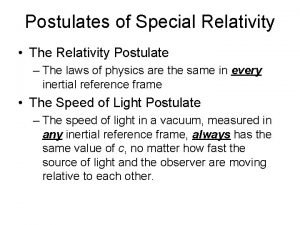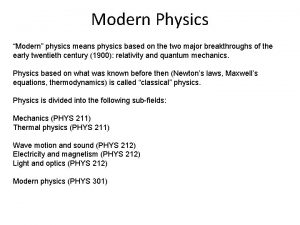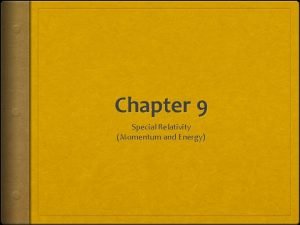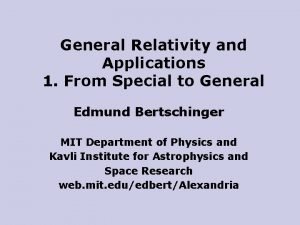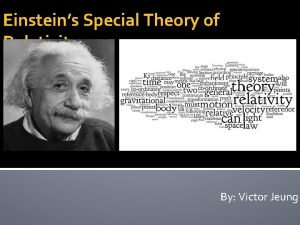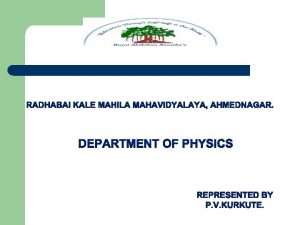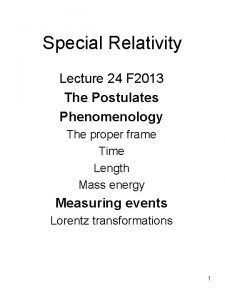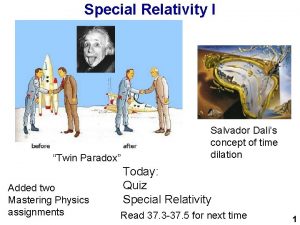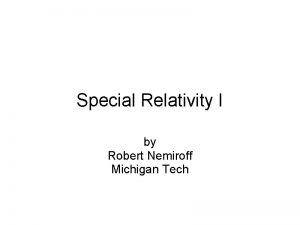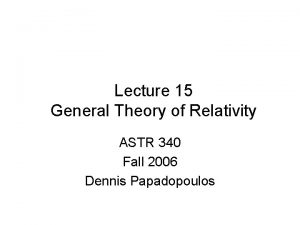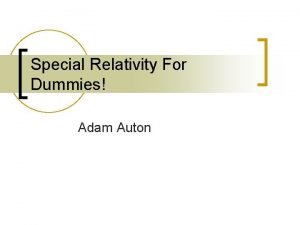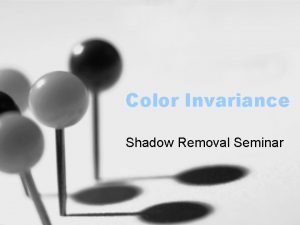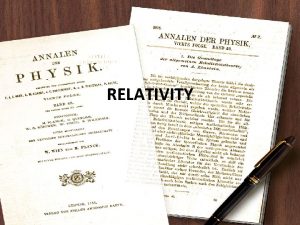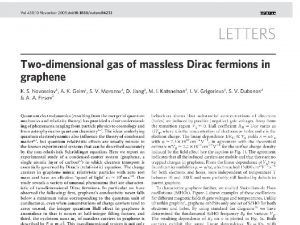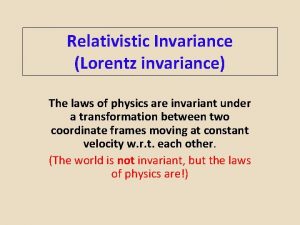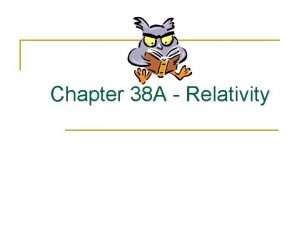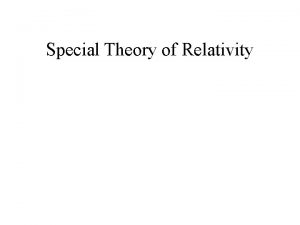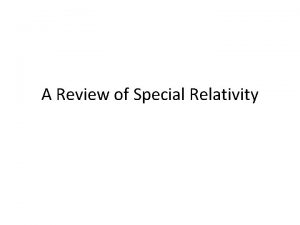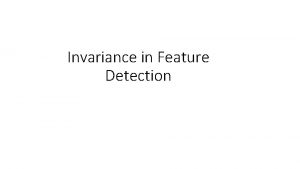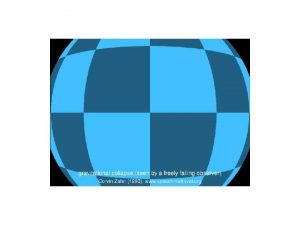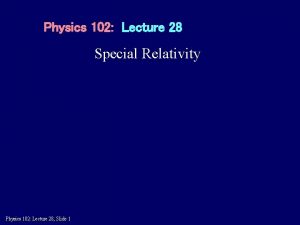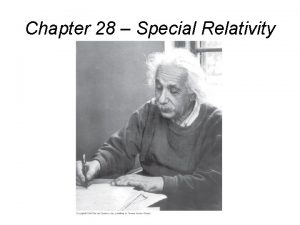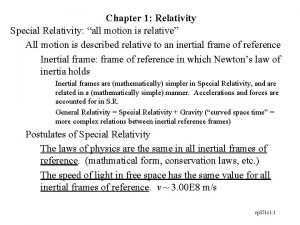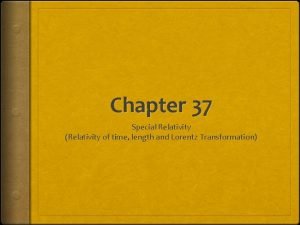Physics 311 Special Relativity Lecture 5 Invariance of

















- Slides: 17

Physics 311 Special Relativity Lecture 5: Invariance of the interval. Lorentz transformations. OUTLINE • Invariance of the interval – a proof • Derivation of Lorentz transformations • Inverse Lorentz transformations

Space and time separation in moving frames • Two events are recorded in two frames: the Lab frame and the Rocket frame (moving at v = 4/5 c). The events are: • Light flash is emitted from the Rocket normal to the direction of relative motion (Event 1) • Light is reflected back and later detected at the Rocket (Event 2) • The two events have zero space separation in the Rocket frame: the light was reflected right back to the rocket • Distance to the reflecting mirror is 3 m, perpendicular to the direction of the Rocket motion. (Remember: the transverse dimension is the same in all frames, follows from the isotropy of space) • Enough words, let’s look at the events in the two frames!

1. The Rocket frame • The events are separated by 0 m of space and 6 m of time s 2 = 62 – 02 = 36, thus s = 6 3 m Event 1 Event 2

2. The Lab frame • The events are separated by 8 m of space and 10 m of time (we’ve secretly used Pythagorean theorem to calculate that) s 2 = 102 – 82 = 36, thus s = 6 (Notice how light travels in a different direction in the Lab frame) 5 5 m m 3 m Event 2 Event 1 8 m

We’ve just proved a very important thing. . . 6=6

General case • Light flash is emitted (Event 1) • Light is reflected back from a mirror d m away and detected (Event 2) • The events are recorded in two frames: the Lab frame and the Rocket frame flying at velocity v • Rocket frame: Δx. R = 0, Δt. R = 2 d, s = 2 d • Lab frame: Δx. L = vΔt. L , Δt. L = 2((Δx. L/2)2 + (Δt. R/2)2)1/2 (Pythagorean theorem) s. L 2 = Δt. L 2 – Δx. L 2 = Δx. L 2 + Δt. R 2 – Δx. L 2 = Δt. R = 2 d d Δx. L Well, it’s a mildly general case, you say. But any two events can be represented this way!

Lorentz transformations • Lorentz transformations give us means to calculate relationships between events in spacetime, including velocities measured in moving frames, electric and magnetic fields, time dilation and length contraction. • More powerful than the intervals alone, Lorentz transformations are a useful mathematical tool. Yet, they are not fundamental, but simply follow from the relativity principle and the invariance of the speed of light. • As any transformation of coordinates for inertial frames, Lorentz transformations must be linear: x = Ax’ + Bt’ t = Cx’ +Dt’ • As relativistic transformations, they must conserve the interval.

Derivation – the setup • The setup: Lab frame at rest, Rocket frame is moving at speed v along the x-axis. • The Lab coordinates are x, y, z and t; the Rocket coordinates are x’, y’, z’ and t’ • Initial conditions: t = t’ = 0; the origins coincide z’ z t’ t x’ x y v y’

Derivation – the plan • Use the invariance of the interval to derive coordinate and time transformations for events in the origin of the Rocket frame (x’ = 0) • Realize that any point in the Rocket frame can be the origin (i. e. the transformations must be linear, space is uniform. . . ) • Derive the transformations for arbitrary x’ and t’ • Derive the inverse Lorentz transformation – from (x, t) to (x’, t’)

Step 1: event at x’ = 0 • Light flash is emitted at x’ = 0 at time t’ • Note: the orthogonal coordinates y and z do not change: y = y’ z = z’ • Spark location in the laboratory frame is (the origins coincided at t = 0): x=vt • Now use the invariance of the interval: (t’)2 – (x’)2 = (t’)2 – 0 = t 2 – x 2 = t 2 – (v t)2 = t 2(1 – v 2) • (Remember: v is unitless, it is the ratio of v/c)

Time and distance transformations for x’ = 0 • Now we can write down the transformation for time: t’ = t(1 – v 2)1/2 , or t = t’/[(1 – v 2)1/2] • Common notation: 1/[(1 – v 2)1/2] ≡ (a. k. a. time stretch factor or simply Lorentz -factor) • Then: t = t’ • Substituting this into x = v t, we get transformation for x: x = v t’ • Is that all we need? Not really, there’s a bit more work to do.

Any point is a reference point • Recall: the transformations must be linear in x (and x’), which follows from the fact that any point in space in any frame cam be a reference point. (Which, in turn, follows form the fact that space is uniform. ) • The transformations must be linear in t (and t’), because any point in time can be chosen as the origin. (This follows from the fact that time is uniform. ) • So, we seek the following form for the transformations: x = Ax’ + Bt’ t = Cx’ +Dt’

Lorentz transformations for arbitrary x and t • We already know the coefficients B and D from the previous derivation: B = v and D = • To determine A and C let’s consider an event at some (arbitrary) x’ and t’. The interval in the two frames is: s 2 = t 2 – x 2 = t’ 2 – x’ 2 • Substitute the expressions for x and t from the full Lorentz transformations: (Cx’ + t’)2 – (Ax’ + v t’)2 = t’ 2 – x’ 2 C 2 x’ 2 + 2 t’ 2 + 2 C x’t’ – A 2 x’ 2 +v 2 2 t’ 2 +2 Av x’t’ = t’ 2 – x’ 2. . . a mess! (But that’s just a normal situation half-way through any derivation)

Lorentz transformations for arbitrary x and t • Group together the coefficients of t’ 2, x’ 2 and x’t’: 2(1 - v 2)t’ 2 – (A 2 – C 2)x’ 2 + 2 (C - Av)x’t’ = t’ 2 – x’ 2 • Let’s study these coefficients. The equality must be satisfied for each and every value of x’ and t’. That means the coefficients on the right-hand side must be equal to the matching coefficients on the left-hand side: 2(1 - v 2) = 2 x 1/ 2 = 1 – very good! (A 2 – C 2) must equal 1, and 2 (C - Av) must equal 0. • All we have to do is to solve a system of two equations with two unknowns.

Lorentz transformations for arbitrary x and t • Group together the coefficients of t’ 2, x’ 2 and x’t’: 2(1 - v 2)t’ 2 – (A 2 – C 2)x’ 2 + 2 (C - Av)x’t’ = t’ 2 – x’ 2 • Let’s study these coefficients. The equality must be satisfied for each and every value of x’ and t’. That means the coefficients on the right-hand side must be equal to the matching coefficients on the left-hand side: 2(1 - v 2) = 2 x 1/ 2 = 1 – very good! (A 2 – C 2) = 1 2 (C - Av) = 0 • All we have to do is to solve a system of two equations with two unknowns.

Lorentz transformations for arbitrary x and t • The solution is simple: A= C = v • The complete Lorentz transformations are: t = v x’ + t’ x = x’ + v t’ y = y’ z = z’

Inverse Lorentz transformations • To find the inverse Lorentz transformations (i. e. from the Lab frame to the Rocket frame), need to solve the first two equations for x’ and t’: t = v x’ + t’ x = x’ + v t’ • Do this as an exercise! The solution is: t’ = -v x + t x’ = x - v t y’ = y z’ = z t = v x’ + t’ x = x’ + v t’ y = y’ z = z’
 Special relativity vs general relativity
Special relativity vs general relativity Postulates of special theory of relativity
Postulates of special theory of relativity Special vs general relativity
Special vs general relativity Special relativity higher physics
Special relativity higher physics Special relativity
Special relativity Einstein 2 postulates
Einstein 2 postulates 2 postulates of special relativity
2 postulates of special relativity Define modern physics
Define modern physics Momentum special relativity
Momentum special relativity Special relativity summary
Special relativity summary Albert einstein theory of special relativity
Albert einstein theory of special relativity Postulates of special theory of relativity
Postulates of special theory of relativity Postulates of special theory of relativity
Postulates of special theory of relativity Special relativity
Special relativity Special relativity
Special relativity Eddington
Eddington Classical conditioning for dummies
Classical conditioning for dummies Invariance property
Invariance property
